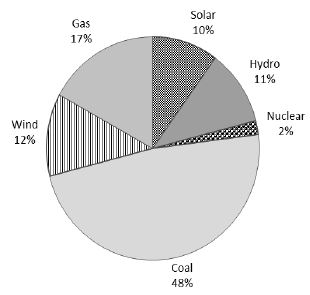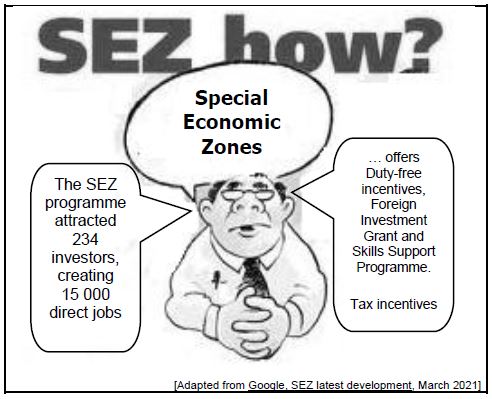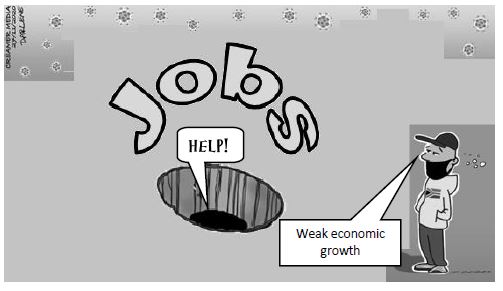ECONOMICS PAPER 1 GRADE 12 QUESTIONS - NSC PAST PAPERS AND MEMOS NOVEMBER 2021
Share via Whatsapp Join our WhatsApp Group Join our Telegram GroupINSTRUCTIONS AND INFORMATION
- Answer FOUR questions as follows in the ANSWER BOOK:
SECTION A: COMPULSORY
SECTION B: Answer TWO of the three questions.
SECTION C: Answer ONE of the two questions. - Answer only the required number of questions. Answers in excess of the required number will NOT be marked.
- Number the answers correctly according to the numbering system used in this question paper.
- Write the question number above each answer.
- Read the questions carefully.
- Start EACH question on a NEW page.
- Leave 2–3 lines between subsections of questions.
- Answer the questions in full sentences and ensure that the format, content and context of your responses comply with the cognitive requirements of the questions.
- Use only black or blue ink.
- You may use a non-programmable pocket calculator.
- Write neatly and legibly.
SECTION A (COMPULSORY)
QUESTION 1 30 MARKS – 20 MINUTES
1.1 Various options are provided as possible answers to the following questions. Choose the answer and write only the letter (A–D) next to the question numbers (1.1.1 to 1.1.8) in the ANSWER BOOK, e.g. 1.1.9 D.
1.1.1 Long-term financial instruments, such as shares, are traded in the … market.
- money
- capital
- foreign exchange
- labour
1.1.2 Business cycles that are caused by changes in the construction industry that last for 15 to 20 years are called … cycles.
- Kuznets
- Kitchin
- Jugler
- Kondratieff
1.1.3 Transfer of ownership of entities from the private sector to the public sector is called …
- privatisation.
- commercialisation.
- deregulation.
- nationalisation.
1.1.4 Investment contracts that base their value on the underlying assets, such as currencies and commodities, are known as …
- other investments.
- direct investments.
- financial derivatives.
- portfolio investments.
1.1.5 The international organisation that reduces tariffs and other trade barriers to liberalise trade is called the …
- World Bank.
- International Monetary Fund.
- World Trade Organisation.
- World Health Organisation.
1.1.6 The growth and development policy that aims to eliminate poverty and reduce inequality by 2030, is known as the …
- National Development Plan.
- Reconstruction and Development Programme.
- Growth, Employment and Redistribution Programme.
- Accelerated and Shared Growth Initiative for South Africa.
1.1.7 A cash incentive that aims to provide investment in the training of the South African labour force to gain new expertise, is called the …
- Critical Infrastructure Programme.
- Skills Support Programme.
- Custom Free Incentives.
- Small Business Support Programme.
1.1.8 The percentage of the population living in poverty in a country is indicated by …
- the Gini coefficient.
- life expectancy.
- per capita gross domestic product.
- the headcount index. (8 x 2) (16)
1.2 Choose a description from COLUMN B that matches the item in COLUMN A. Write only the letter (A–I) next to the question numbers (1.2.1–1.2.8) in the ANSWER BOOK, e.g. 1.2.9 J.
| COLUMN A | COLUMN B |
| 1.2.1 Transfer payment 1.2.2 Investment 1.2.3 Cash reserve requirements 1.2.4 Price discrimination 1.2.5 Social indicator 1.2.6 Desirable mix 1.2.7 Industrial development zones 1.2.8 Expanded Public Works Programme |
|
(8 x 1)(8)
1.3 Give ONE term for each of the following descriptions. Write only the term next to the question numbers (1.3.1 to 1.3.6) in the ANSWER BOOK. Abbreviations, acronyms and examples will NOT be accepted.
1.3.1 When a country involved in international trade, produces more output than other countries given the same input
1.3.2 A document that details expected revenue and projected expenditure for the next fiscal year
1.3.3 Tax systems where low-income earners pay higher tax rates while high-income earners pay lower tax rates
1.3.4 The provision of incentives to encourage local businesses to produce goods to sell to other countries
1.3.5 The process that focuses on the improvement of people's standard of living
1.3.6 The industrial development strategy that focuses on improving the competitiveness in manufacturing by considering input prices and technology. (6 x 1) (6)
TOTAL SECTION A: 30
SECTION B
Answer any TWO of the three questions in this section in the ANSWER BOOK.
QUESTION 2: MACROECONOMICS 40 MARKS – 30 MINUTES
2.1 Answer the following questions.
2.1.1 Name any TWO participants of the circular-flow model. (2 x 1) (2)
2.1.2 Why does public sector failure lead to social instability? (1 x 2) (2)
2.2 Study the table below and answer the questions that follow.
| GROSS VALUE ADDED BY KIND OF ECONOMIC ACTIVITY | ||
| 2021 figures | ||
| At constant 2015 prices | At current prices | |
| Primary sector | 295 203 | 472 082 |
| Secondary sector | 552 601 | 943 771 |
| Tertiary sector | 2 017 745 | 3 107 747 |
| Gross value added at basic prices | 2 865 548 | 4 523 600 |
[Adapted from SARB Quarterly Bulletin, March 2021]
2.2.1 Identify the base year that the South African Reserve Bank uses to compile national accounts aggregates. (1)
2.2.2 Give the alternative term used for gross value added in national accounts. (1)
2.2.3 Briefly describe the term gross value added. (2)
2.2.4 How are basic prices converted to market prices? (2)
2.2.5 Why would economists prefer constant prices to current prices when measuring economic growth? (2 x 2) (4)
2.3 Study the extract below and answer the questions that follow.
PUBLIC DEBT ON THE INCREASE High government debt levels increase the cost of borrowing across the economy. The rising debt leads to higher future taxation and uncertainty. Servicing this rising debt takes away resources that could have been invested in infrastructure. Our borrowing requirement will remain well above R500 billion in each year of the medium term despite the modest improvements in our fiscal position. This 2021 budget framework puts South Africa on course to achieve a primary surplus. By doing this, government debt will stabilise at 88,9 per cent of gross domestic product in 2025/26. [Adapted from 2021/22 Annual Budget Statement] |
2.3.1 Name the government department responsible for the formulation and implementation of fiscal policy. (1)
2.3.2 Give the benchmark percentage of public debt in relation to gross domestic product. (1)
2.3.3 Briefly describe the term medium-term expenditure framework. (2)
2.3.4 Why is there a need for government to spend more on social development? (2)
2.3.5 How can income tax brackets influence taxpayers? (2 x 2) (4)
2.4 With the aid of a correctly labelled graph, explain the multiplier concept. (8)
2.5 How can changes in terms of trade influence the South African economy? (8)
[40]
QUESTION 3: ECONOMIC PURSUITS 40 MARKS – 30 MINUTES
3.1 Answer the following questions.
3.1.1 Name any TWO methods of import substitution. (2 x 1) (2)
3.1.2 How can the government use land restitution to achieve its development and redress objectives? (1 x 2) (2)
3.2 Study the information below and answer the questions that follow.
SOUTH AFRICA'S 2030 ENERGY PLAN As part of the 2030 plan, the Department of Mineral Resources and Energy effectively unlocked R56 billion that will be invested in renewable energy projects across the country. Municipalities are required to select suitable off-grid energy sources and to provide access to poor households. |
3.2.1 Identify the energy source that relates to the burning of fossil fuels. (1)
3.2.2 Give the index that is used to measure society's level of development. (1)
3.2.3 Briefly describe the term economic indicator. (2)
3.2.4 Explain the negative impact of rural-urban migration on the supply of services in urban areas. (2)
3.2.5 How will renewable sources of energy affect poor households in rural areas positively? (2 x 2) (4)
3.3 Study the information below and answer the questions that follow.
[Adapted from Google, SEZ latest development, March 2021]
3.3.1 Identify the financial incentive that allows for the importing of intermediate goods without paying any tariffs. (1)
3.3.2 Name any ONE special economic zone in South Africa. (1)
3.3.3 Briefly describe the term corridors. (2)
3.3.4 How is the government using corporate tax to attract investments into special economic zones? (2)
3.3.5 Explain the importance of public-private partnerships in spatial development initiatives. (2 x 2) (4)
3.4 Outline the aims of regional development. (4 x 2) (8)
3.5 Analyse the environmental effects of economic activities of countries in the north. (8)
[40]
QUESTION 4: MACROECONOMICS AND ECONOMIC PURSUITS
40 MARKS – 30 MINUTES
4.1 Answer the following questions.
4.1.1 Name any TWO international benchmark criteria for regional development. (2 x 1) (2)
4.1.2 Why are liabilities added when calculating net direct investments in the financial account of the balance of payments? (1 x 2) (2)
4.2 Study the extract below and answer the questions that follow.
WHY DO COUNTRIES TRADE? Today, international trade is at the heart of the global economy and is responsible for much development and prosperity of the modern industrialised world. Countries trade with each other when they do not have the resources, or capacity to satisfy their own needs and wants. By exploiting their domestic scarce natural resources, countries can produce a surplus and trade this for the resources they need. |
4.2.1 Identify the supply reason for international trade addressed in the extract above. (1)
4.2.2 Name the product explicitly recorded in the current account, due to its historic importance. (1)
4.2.3 Briefly describe the term mass production. (2)
4.2.4 Explain the reason for South African consumers importing products that are available on domestic markets. (2)
4.2.5 How could natural disasters, such as a drought, influence the South African trade balance? (2 x 2) (4)
4.3 Study the information below and answer the questions that follow.
SOUTH AFRICA'S ECONOMY HITS LOW South Africa's gross domestic product (GDP) fell by just over 16,4% between the first quarter and second quarter of 2020, resulting in an annualised growth rate of -51%. The demand side of the economy slumped by 52,3% as a result of lower exports and household spending. |
4.3.1 Identify ONE component of aggregate demand in the information above. (1)
4.3.2 Name the employment indicator that relates to the size of the labour force in the country. (1)
4.3.3 Briefly describe the term economic growth. (2)
4.3.4 Explain the impact of an increase in consumer spending on the production of goods and services. (2)
4.3.5 How can small, medium and microenterprises (SMMEs) contribute to economic growth and development? (2 x 2) (4)
4.4 Briefly discuss exchange rate stability and price stability as macroeconomic objectives of the state. (2 x 4) (8)
4.5 Analyse the challenges of the South African government in reducing the unemployment rate in the economy. (8)
[40]
TOTAL SECTION B: 80
SECTION C
Answer any ONE of the two questions in this section in the ANSWER BOOK.
Your answer will be assessed as follows:
| STRUCTURE OF ESSAY | MARK ALLOCATION |
| Introduction
| Max. 2 |
| Body Main part: Discuss in detail/In-depth discussion/Examine/Critically discuss/Analyse/Compare/Evaluate/Distinguish/Differentiate/Explain/Draw a graph and explain/Use the graph given and explain/Complete the given graph/Assess/Debate A maximum of 8 marks may be allocated for headings/examples. Additional part: Critically discuss/Evaluate/Critically evaluate/Debate/ Deduce/Compare/Distinguish/Interpret/How?/Suggest A maximum of 2 marks may be allocated for mere listing of facts. |
Max. 26
Max. 10 |
Conclusion
|
Max. 2 |
| TOTAL | 40 |
QUESTION 5: MACROECONOMICS 40 MARKS – 40 MINUTES
- Discuss in detail the new economic paradigm in smoothing-out business cycles. (26 marks)
- Evaluate the South African government's initiatives to reduce the economic downturn caused by the Covid-19 pandemic. (10 marks) [40]
QUESTION 6: ECONOMIC PURSUITS 40 MARKS – 40 MINUTES
- Discuss the arguments in favour of protectionism. (26 marks)
- How can South Africa benefit from trading in global markets? (10 marks)
[40]
TOTAL SECTION C: 40
GRAND TOTAL: 150


